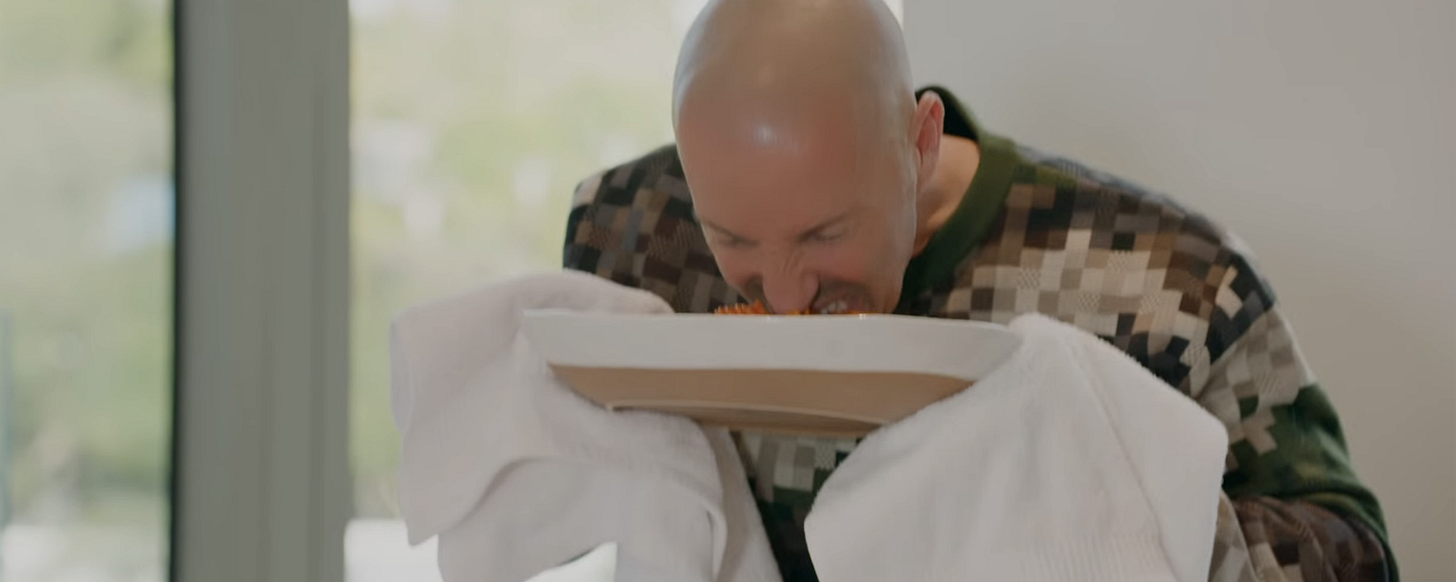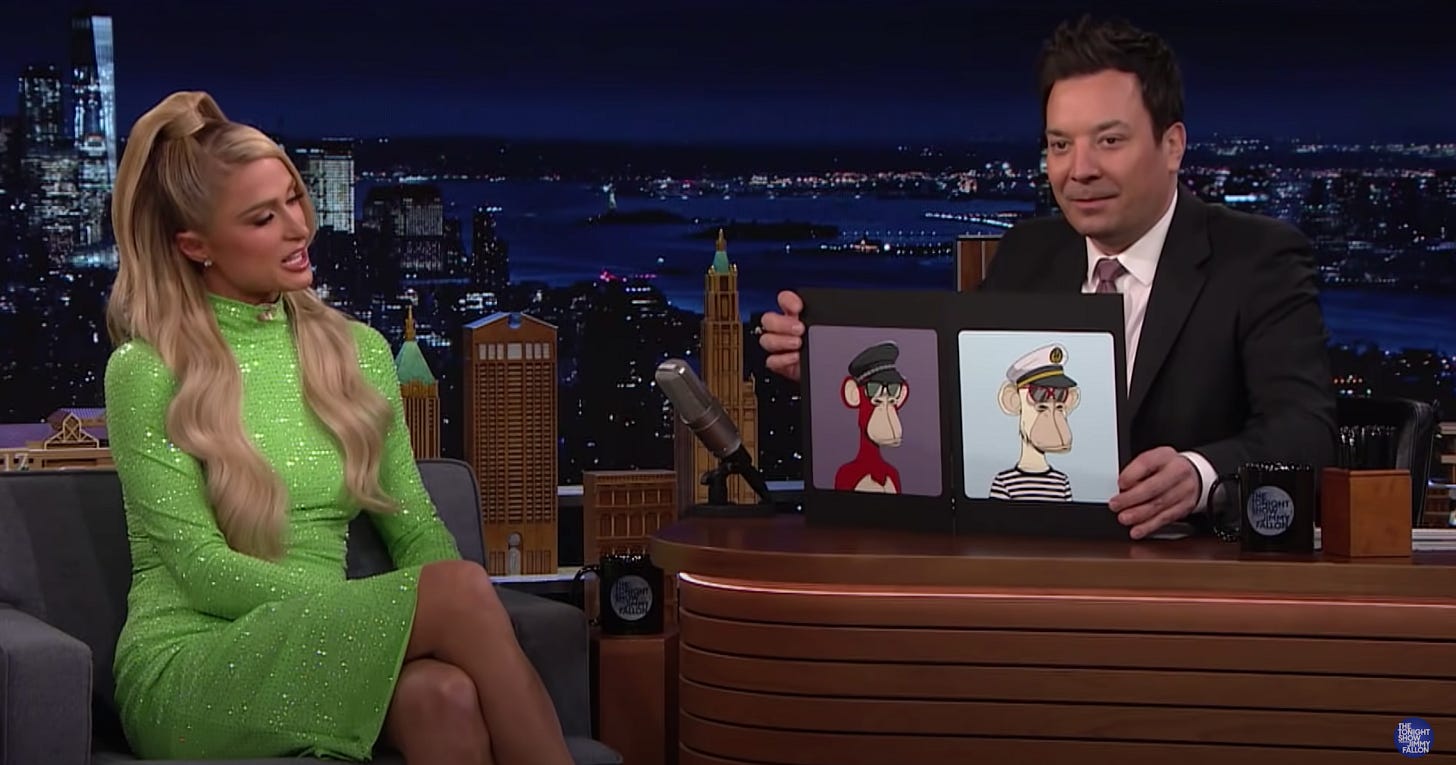Jason Oppenheim’s Sweaters and the Rich’s Colonization of Taste
What $2k sweaters and $1M marble bathrooms tell us about the rich poisoning creative communities.
Okay, So, we all know that watching Selling Sunset is embarrassing. The Netflix reality show features real estate agents touring and selling unfathomably expensive property in LA while dealing with interpersonal, Shonda Rhimes-level drama. But as the program has grown in viewership and popularity, each cast member’s influencer career and income has exploded, rendering the labor of selling houses redundant. The success of a show based on people doing a job has made the job unnecessary, evolving it into the performance of labor as labor - which is very weird.
Selling Sunset has become about only two things: the manufactured magnification of petty drama to tectonic catastrophe, and extreme fashion. In the cast’s competition to earn screen time, they’ve all reshaped themselves into caricatures for our enjoyment. For the women, the artifice is obvious: Chelsea Lazkani fully wrapped up in a latex tuxedo, tears streaming down her waterproof beat over the mere possibility of her husband cheating; Bre Tiesi snapping the heel off her Louboutins and then giving a glimpse of her coated and unmarred (unworn) soles.
While the women are engaged in high drag, artfully performing high-end femininity, it’s the men, whose uncomfortability with fashion and their own self-expression, that give us a window into how the wealthy have successfully poisoned creative spaces. Without the show’s central conceit in action, Selling Sunset reveals how America’s rich, unsatisfied with mere millions in gauche American dollars, are colonizing taste.
A mid-season episode introduces viewers to Johnny Manziel, Bre’s ex-husband and a retired football player. His anguish is obvious as he balances his pain with his desire to reattract the bombshell that got away. His personal style is also a war between the internal and external, between what he feels he must wear versus his personal taste. Bre calls him out for his terrible Gallery Dept. hoodie dotted by smudges of paint that he didn’t apply. (This is a strange design choice given that Gallery Dept. makes artfully and successfully self-aware, paint-covered meta commentary pieces. But this hoodie seems to take itself seriously, no longer in on the joke.)
He wears his $650 hoodie on top of Travis Scott Low Jordans ($1200), a Kith beanie ($65), and flimsy pants (idk, they look $20? but they’re probably like $800). The monotone choices seem clumsily balanced to highlight the hoodie and sneakers while looking as cheap as possible. Nary has so much effort gone into performing tortured effortlessness. The outfit does little to feature what makes any of these pieces unique or desirable. And it does not look effortless. Unless he’s chosen slovenliness to lure Bre into a repeat relational renovation, it’s giving money pit.
Counter to Manzel’s bewildering anti-choice choices, agency boss Jason Oppenheim finds one single style choice per season and runs it. Last season it was “Burberry button-downs”, this season it’s “Prada polos”, but the real attention grabbers are two Louis Vuitton exceptions he wears at his storylines’ most pivotal moments.
The Damier Cotton Jacquard Pullover ($1930) he wears to a post-dog funeral pot luck is especially beautiful (a riff off the superior Damier Classic Denim Jacket). And a Damier Cotton Sweatshirt balloons over his frame in his final scene of the season. Jason’s stylist is obviously trying to project wealth and cultural consciousness.
But these pieces do not fit Jason’s body and they’re still so stiff from the store that the fabric hasn’t relaxed onto his body. The sweatshirt’s apparent stiffness tells us that Jason doesn’t wear these pieces unless the cameras are rolling. They betray themselves as costuming. Jason is acquiring clothes the same way he buys $270k cars: with little to no consideration or aspiration in the decision. It’s a submission to aesthetics and an act of acquisition rather than an expression of perspective.
He is projecting that he spends a ton of money on his clothes without the quiet luxury of Loro Piana or Brioni or other, subtler brands. Shopping exclusively within loud luxury means his current choices are limited. But the constant churn, the visible conveyor belt of expenses, are central to his identity as the king of LA real estate. A crowned monarch in the City of Artifice.
~
A genuine benefit of Selling Sunset is that we poors are allowed to glimpse what budgetless property can look like. And Jason, an expert in houses and interiors, can wax Socratic about all the virtuous and tasteful choices in these hidden estates and clandestine compounds. In his final scene, we watch as he makes an unwelcome argument that Tadao Ando’s work is still present and alive in a Malibu home destroyed by Kanye West .
When Jason makes this argument to his staff, they are incredulous. “These numbers are not making sense,” says Emma Hernan in a confessional. “I think you are correct, this is nuts to take on this listing,” Alanna Whittaker tells him to his face.
But Jason can see the vision.
Ando, who is still alive, completed the project in 2013 and West was only the house’s second owner, buying it in 2020. But in the few years that West owned it, he ripped everything out of it except the bones. The glazing, electric, plumbing, cabinetry, HVAC, everything, is gone. Even the concrete that makes up the soul of the place is eroding. This was a masterpiece by a living legend, a jewel of Brutalist architecture, that West bought at the height of his cascading personal crises and intentionally destroyed. Whether he intended to repair it in the future, it never happened. (Architecture is an art form that requires private ownership, but does that give wealthy owners the right to annihilate unique work in the world just because they own it?) In this case, once the billionaire pulled the wings off an architectural butterfly, he moved onto the next distraction. Then Jason stepped in to bring it back to life.
“All of the work of Ando is still here,” Jason says, assuring the agents the deal would happen. And he was right. The sale was announced a week before this seemingly ill-fated argument went live on Netflix. Jason was able to do it because the extraordinarily wealthy seek him out to help them parse through architectural expressions and design choices they don’t see or understand (and because he reduced the price by $36M). He’s the expert that others seek out. I wish Jason would also seek out expertise.
Fashion and style are art forms, just like architecture and interior design. While cocooning a bathroom in Breccia Capraia marble can be a beautiful choice, placing that bathroom in a 600 sq ft Los Feliz ranch is tantamount to pairing skin-tight pants with an ill-fitting Pharrell designed Louis Vuitton sweatshirt. The difference is context.
~
At the turn of the last decade, those of us who love streetwear were happily minding our own business when Instagram introduced Wall Street money to graphic tees, when the casual revolution took hold of corporate America, and MBAs had to learn what was cool. Everyday at Kith in 2012 and 2013, sweaty striped Brooks Brothers shirts and ill-fitting Banana Republic chinos shuffled in from Bleecker Street asking “What’s cool?”, their faces twisted, horrified at the suggestion of a New Balance, shaping their mouths around the word “collaboration” for the first time, learning what a “Tier Zero Account” is.
Soon, the collaborative market exploded. The foundation was set by collaborations with boutiques, then artists like Pharrell and Pusha-T, and eventually Kanye West - not necessarily in that exact order. But it was arguably Jordan Brand’s flexibility with the artist KAWS that opened the door for the iconic Virgil Abloh Off-White x Nike collections. With the names of sneaker collaborators gracing CNBC and The New York Times on a regular basis, the lessons the MBAs learned on their Saturday morning trips to SoHo began to carry more weight among their friends that spent those same hours in Westchester golfing. The shortcut creative discourse for late adopters was flowing.
Later, when platforms like StockX and Grailed exploded, they provided the opportunity for anyone to get their hands on collectable items that had previously required navigating opaque communities and taking financial risks. When I introduced the world to StockX, I argued that it represented the democratization of sneakers. And while democratization is never a mistake, in capitalism, ownership is often confused with expertise.
The wealthy donned their cool costumes of non-OG Jordans and non-BOGO Supreme tees, lashing the aesthetic to monetary and corporate success, setting a new standard for the digitally- and upwardly-desperate. The look was cast as a new aesthetic cipher for cultural greed and these warriors congregated to discuss Crypto, a new frontier for the middle class to claim themselves financial Nostrodomi and fleece the poorer among them. The conversation pushed further online with screeds about NFTs, an opportunity for the wealthy to do the same under the guise of “art.”
NFTs tickled the same impulses that sneaker reselling pretended to (cultural cache meets quick profits) with the added feature of a more explicit investor payoff - as long at the MLM scheme perpetuated. That's what NFTs were: a promise of financial astuteness, but selling them required a veneer of artistic legitimacy.
The trade of pixelized, randomized faces or digital apes under the claim of creativity by philistines who were making memes about Rothko just seasons earlier, was now supposed to change the face of art forever, a kind of crowdfunded patronizing that materialized for a few artists, and mostly worked as a pump and dump scam for day-trading influencers.
The proliferation of AI as a faux-democratization of creative expression is really a way for wealthy people to again colonize what they don’t understand. Money used to be enough for wealthy people, but now they believe they need to be stylish and creative. (This argument is often made on the backs of other communities, often the disabled, as NaNoWriMo found themselves arguing as a way to defend the money the received from their AI investors.)
Would we have gotten those NFTs if KAWS never made his Jordan IVs? Were sneaker collaborations like KAWS, then Abloh, the precursor to NFTs? Did allowing idiots to buy into those spaces and call themselves stylish with a material transaction open the door for AI? Like the frogs in the pot, we may never know why the water got hot, but we all got burned.
While Abloh may have found himself the artistic director of Louis Vuitton without the success of his sneaker collabs, and Pharrell may have become the creative director of LV if Abloh hadn’t passed away, their careers would have looked a lot different without those features. And Jason would never have his sweaters.

Like with all colonization, we risk losing something of real value when this behavior perpetuates. When the invading force shoulders its way into the native space, it demands to take over. As we’ve experienced the Private Equity destruction of Red Lobster, Wall Street’s poisoning of Warner Brothers Disc. and corruption of Arkane Studios, AI’s enshittification of basic Google searches, we see how an influx of money into creative or useful spaces ignites an unquenchable hunger that leads to a death spiral.
Fashion’s central conceit of offering unique expression inside a finite collection of pieces created for other theses will always push the curious outside the mainstream if the mainstream won’t satisfy. And every fashion house has its own natural expansions and contractions. But anti-influence is real. Jason Oppenheim is no anti-influencer, but when styling is not based in contextual understanding, micro trends from the over-exposed risk poisoning audiences against work that would otherwise reward sophisticated analysis.
Money can’t buy everything, but it can buy an education. I wish more wealthy people saw the world as a place to explore rather than colonize. I wish these titans of industry could rejoice in the joy found and shared by others. I wish they didn’t feel the need to stick their own flags in it, stabbing deep wounds, all while claiming discovery.
Maybe they colonize these creative spaces because it makes the rest of their behavior feel better. Maybe our modern dragons gaze upon their hoards and realize it’s not the gold that makes them fly.
~~~~
I’d love to hear your thoughts on these topics in the comments! This isn’t canned copy - I want to hear what you have to say!
Also, I’m working on a number of other essays and would love to hear what you’re most interested in. Since many of these are already in the works, it won’t necessarily decide what’s next, but might move some up.













